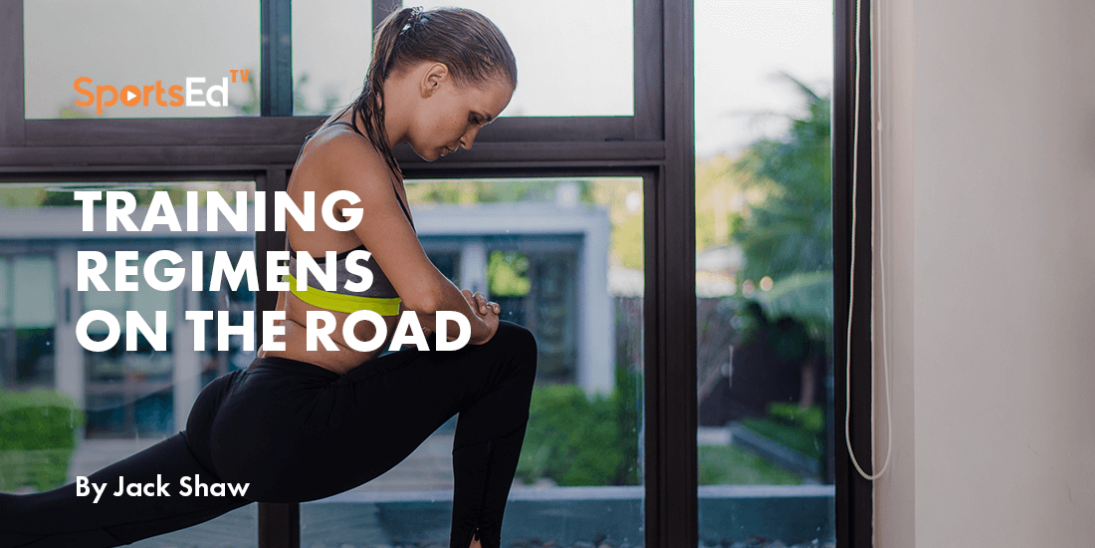Strength And Conditioning
Welcome and thanks for visiting...

Strategies for Keeping Up Training Regimens on the Road

Your fitness routine is easy to maintain at home, thanks to your familiarity with local exercise centers and grocery stores. However, visiting other locations can throw you for a loop. Unfamiliar territory means you may have trouble sticking with your routine, whether the trip is for vacation or work. Fortunately, being creative will help you keep up your training regimens on the road. Here’s a guide to maintaining your fitness habits anywhere you travel.
How Can You Maintain Your Training Regimen on the Road?
Traveling means seeing new people and places, but it doesn’t have to exclude your fitness. Here are six tips for maintaining your fitness regimen while traveling.
1. Create a Routine
Leaving home can take you out of your groove, so creating a routine at your new destination is crucial. The first day may be challenging due to jet lag or travel fatigue, so take a day to adjust to the new time and place. Once acclimated, carve out time from your itinerary for exercise. Incorporating exercise into your schedule makes you more likely to follow through and stay on track.
A 2023 study shows those who do morning workouts have a lower risk of obesity, so make sunrise exercise your priority. Suppose you’re in town for a conference beginning at 8 a.m. each morning. Wake up early for an invigorating workout to energize your body and heighten focus. If a morning workout isn’t possible, find time in the afternoon or evening. Putting training on your schedule is the first step toward success.
2. Find Outdoor Opportunities
Gyms are the most conventional spot to work out, but your travel destination might be short on these fitness centers. Additionally, the locations may lack the necessary equipment or allow non-members to use the facility. Outdoor opportunities may be your best friend in these situations.
The outdoors gives you plenty of space and flexibility to work out if you can find room. For instance, research the area for tennis courts and work on your weaker skills. The time away from home could be useful for improving your base and setting the foundation for better tennis play.
3. Be Creative
Remote areas might not provide the facilities you need for your typical workout, so you must be creative. Use traveling to your advantage by exercising in unconventional places.
Your road trip could include stops at rest areas to do a workout. These off-highway locations typically include large grassy areas, so utilize this land for quick exercises. While practicing specific sports like basketball may be challenging, you can do jumping jacks, pushups and various cardio exercises to get your mind right for the drive ahead.
Your hotel room is another unorthodox place to take advantage of your trip. While sprints may be more difficult here, your temporary room can be a worthwhile place for strength training. Bring dumbbells, resistance bands and other helpful equipment to build your fitness inside the hotel room.
4. Exercise With a Friend
If companions come with you on the trip, ask if they want to work out with you. Finding a workout buddy provides an accountability partner to ensure you maintain your exercise plan. The CDC says exercising with a partner is motivating due to the friendly competition and encouragement you can give each other. Plus, you can give each other actionable advice to help each other’s form.
If you can’t find a partner, you might not have to work out alone. Find training videos online to guide your workouts and utilize a virtual partner. For example, use instructional videos to practice the cone mine drill and improve your foot skills in soccer.
5. Remember Your Nutrition
Being away from home can make keeping up with your nutrition more complex, so ensure your meals support your exercise habits. Hotels, airports, and gas stations might have different food options from your trusted local markets, so you’ll need to plan by bringing snacks from home and carefully ordering food from restaurants.
Non-perishable snacks are excellent options to ensure they remain edible for your trip. Nuts suit athletes because they provide energy through fat and protein and fit into numerous diet plans. Energy will be essential on your travels, so bring fresh or dried fruit to give your body the carbohydrates it needs to perform. These simple snacks go a long way in maintaining your exercise routine.
6. Maintain Your Sleep Schedule
Traveling includes busy schedules, long drives, and plane rides, so finding time to sleep can be challenging. However, you should focus on maintaining your sleep schedule for the trip to rest and re-energize yourself for the days ahead. Experts recommend adults should sleep between seven and nine hours nightly to keep their bodies healthy and avoid sleep deprivation.
Cultivate a proper sleep environment in your hotel room or wherever you’re staying by changing the thermostat to your liking and closing the curtains for darkness. Bring portable humidifiers, white noise machines, and other systems if they will help you sleep away from home.
What Planning Is Necessary for Traveling Workouts?
Maintaining your training regimen is easier when you plan before the trip, so use these three tips to organize your exercise when traveling.
Pack Your Training Gear
Bringing your exercise equipment with you is one way to ensure you have your trusted workout tools on the road. Your suitcase and duffle bag should be large enough to fit small devices, such as resistance bands, yoga mats, and jump ropes. If you’re flying, check the airline’s requirements for sports equipment because you’ll want to comply with the rules. For instance, United Airlines permits one tennis racket case in your checked or carry-on bag.
Hauling Heavy Equipment
Larger equipment may need more creative solutions for transportation. Most airlines allow for things like bicycles as checked luggage, but driving cross-country requires some more planning. Roof racks can be helpful but have limited weight capacity. If you’re looking to bring bulkier equipment, utility trailers are likely your best bet to keep the haul lightweight and cost-effective. Plan ahead and opt for an enclosed trailer if you fear the weather may cause issues for your belongings.
Maintain a Healthy Balance
Going on the road means visiting new places and making lasting memories, whether alone or with friends. Use this trip as an opportunity for fun and maintain a healthy balance of exercise and leisure. Some experiences — such as national parks — let you combine fun and fitness on the same day. Most parks have short trails ranging from 1-5 miles, providing excellent space for running and sightseeing.
Finding Your Fitness on the Go
Maintaining your exercise routine on the go can be challenging because you don’t have your usual amenities. However, creative planning can make the job more manageable regardless of your trip’s length. Research the destination to find fitness centers, recreational areas, and stores with healthy food. If you’re on a road trip, plan strategic stops to fit exercise into your itinerary.








